over 1 year
ago -
PDXRyagi
-
Direct link
Good afternoon everyone and welcome! This week we will be covering multiple nations through the lenses of 2 Developer Diaries, one for Qara/Aq Qoyunlu and one for Georgia/Armenia in the thread below!
Embroiled in both external and internal conflicts, the Turkomans in the Middle East offer a very interesting playthrough including government mechanics, events, and now completely new mission trees, government reforms, and more! Both tags share similar mission trees, each imbued with unique branches for AQ and unique branches for QQ.

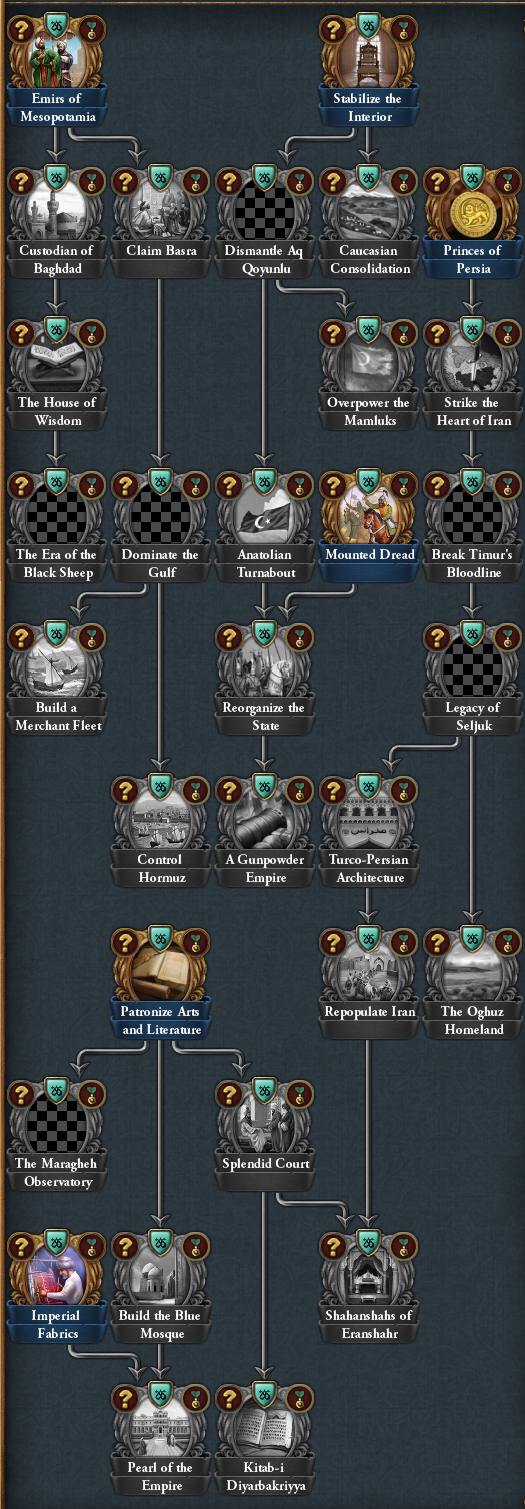
QQ and AQ will largely share most missions, each tree granting certain diversity in key points.
Despite its smaller size compared to its Eastern neighbor, AQ starts at a much stable situation (more on that further down!). In 1444 the legendary Uzun Hasan stands as the heir to a Tribal Federation ready to spread its wings and bring the surrounding territory under its heel.
The AQ mission tree offers 31 new missions, interacting with nearly every facet of gameplay, from conquest and integration to estate interaction and events. Your first tasks would be to eradicate the last remnant of the Ayyubids in Hisn Kayfa, and rally your powerful cavalry. The former will then give rise to aspirations for expansion in every direction while the latter mission (Rally the Turkomans) will play around with the existing Tribal Allegiance mechanic and grant a bonus to province warscore cost.
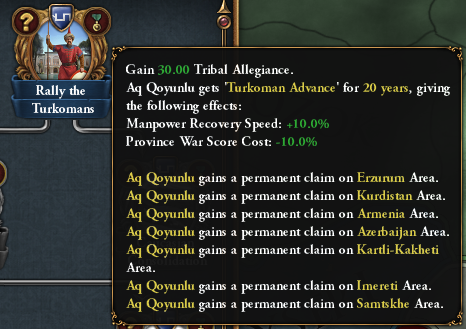
At the same time, you will be called to eradicate one of the last Roman bastions in Eastern Anatolia, Trebizond, offering a unique event reward:
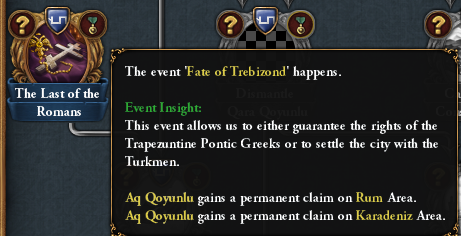
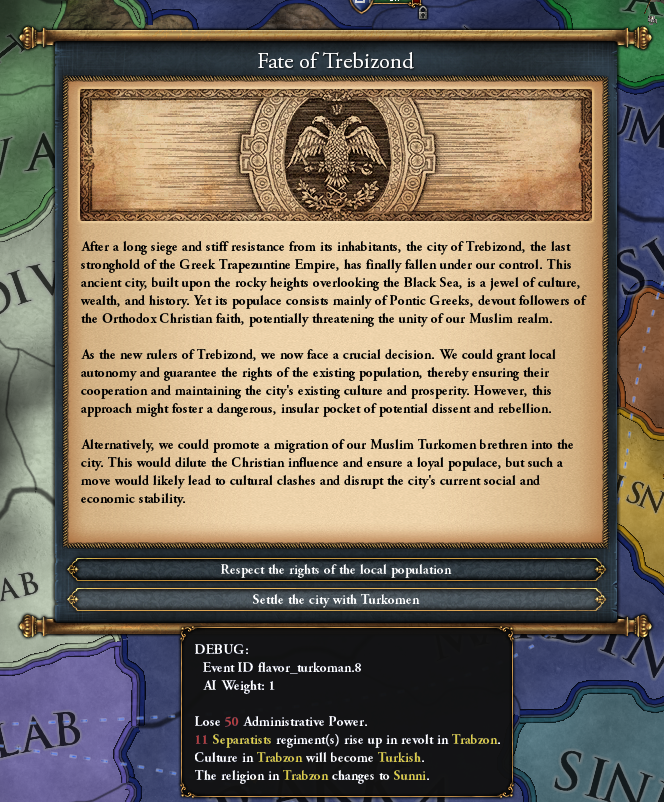
The first option of the event will grant some prosperity over time in the entire state as well as some reduction to local autonomy among other minor rewards.
Another highlight of the Aq Qoyunlu conquest path is “The House of Wisdom”. The House of Wisdom in Baghdad was a renowned center of scholarship and intellectual activity in the Islamic world. Established during the Abbasid Caliphate in the 8th and 9th centuries, it continued to flourish into later centuries, being a hub of learning, translating, and preserving ancient Greek, Persian, and Indian texts, contributing significantly to the Islamic Golden Age. Scholars from various backgrounds gathered there to engage in scholarly pursuits, making significant advances in fields like astronomy, mathematics, medicine, and philosophy. The House of Wisdom's enduring legacy lies in its role in preserving and transmitting knowledge, which later influenced the European Renaissance and the broader development of human civilization. Therefore, there will be a mission about fully restoring it:
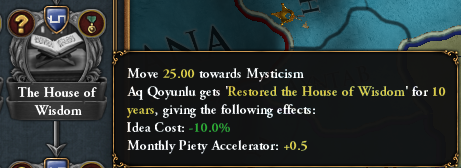
To wrap up the showcasing of conquest for Aq Qoyunlu, let’s take a look at “A Gunpowder Empire”. This is a term coined for empires such as the Ottomans, Safavids, and Mughals, as they used this new warfare technology to expand their territories and dominate their regions. Their military strength and control over trade routes were largely built upon their mastery of gunpowder weaponry and tactics, and Aq Qoyunlu may be able to join that group as well:

Moving on to the internal part of the content, we will be greeted by objectives centered around an improved court, the patronization of art and literature, as well as the development of new imperial fabrics:
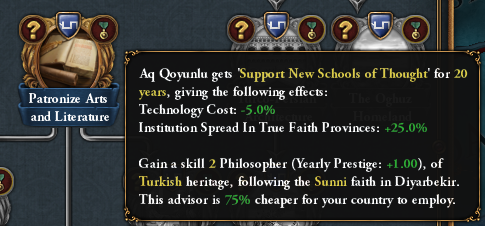
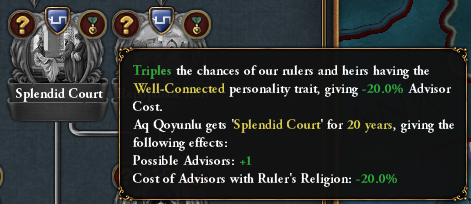
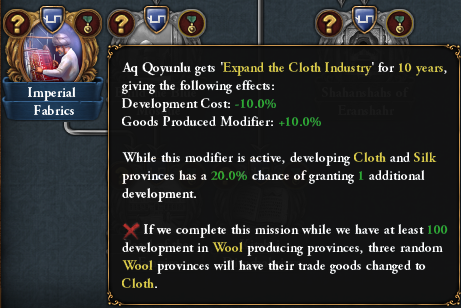
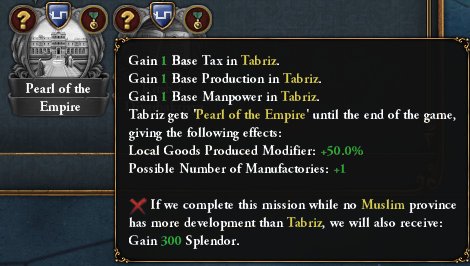
Finally, let’s take a look at some more highlights before we move on to the Black Sheep:
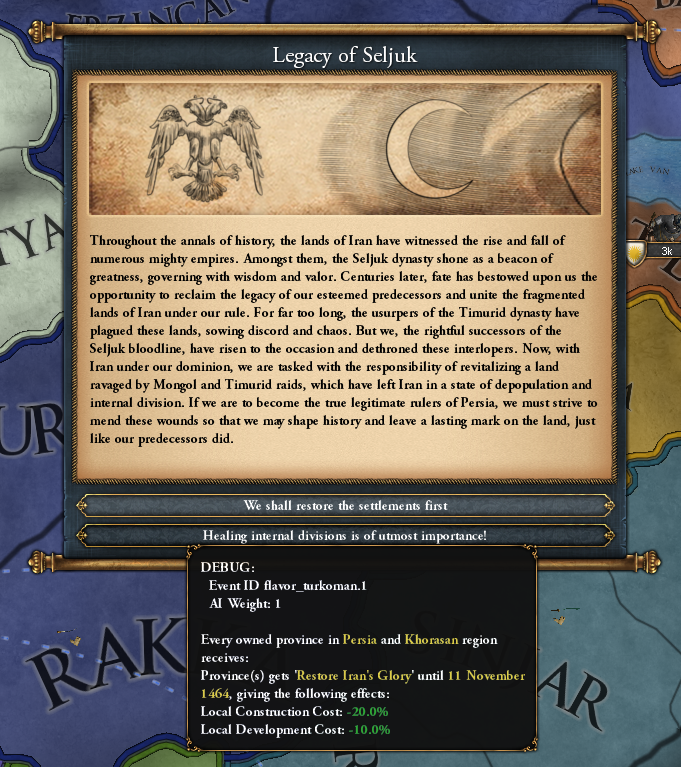
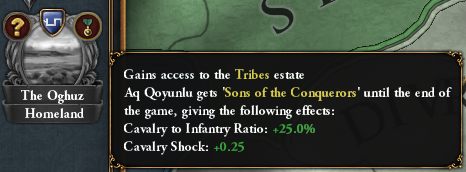
The Black Sheep on the Eastern border suffered a turbulent time during the middle of the 15th century. In 1444 the lands around Mesopotamia were highly autonomous and far away from the central domain in Tabriz. As a result, the lands that fell in the hands of Ispend Mirza (brother of Jahan Shah) created a thorn in the side of the government, resisting the payment of taxes and drafts, thus posing a significant threat to Jahan’s rule. We decided to represent the Emirate of Baghdad via an Estate Privilege, which increases the autonomy in select areas via a flat and a monthly amount:
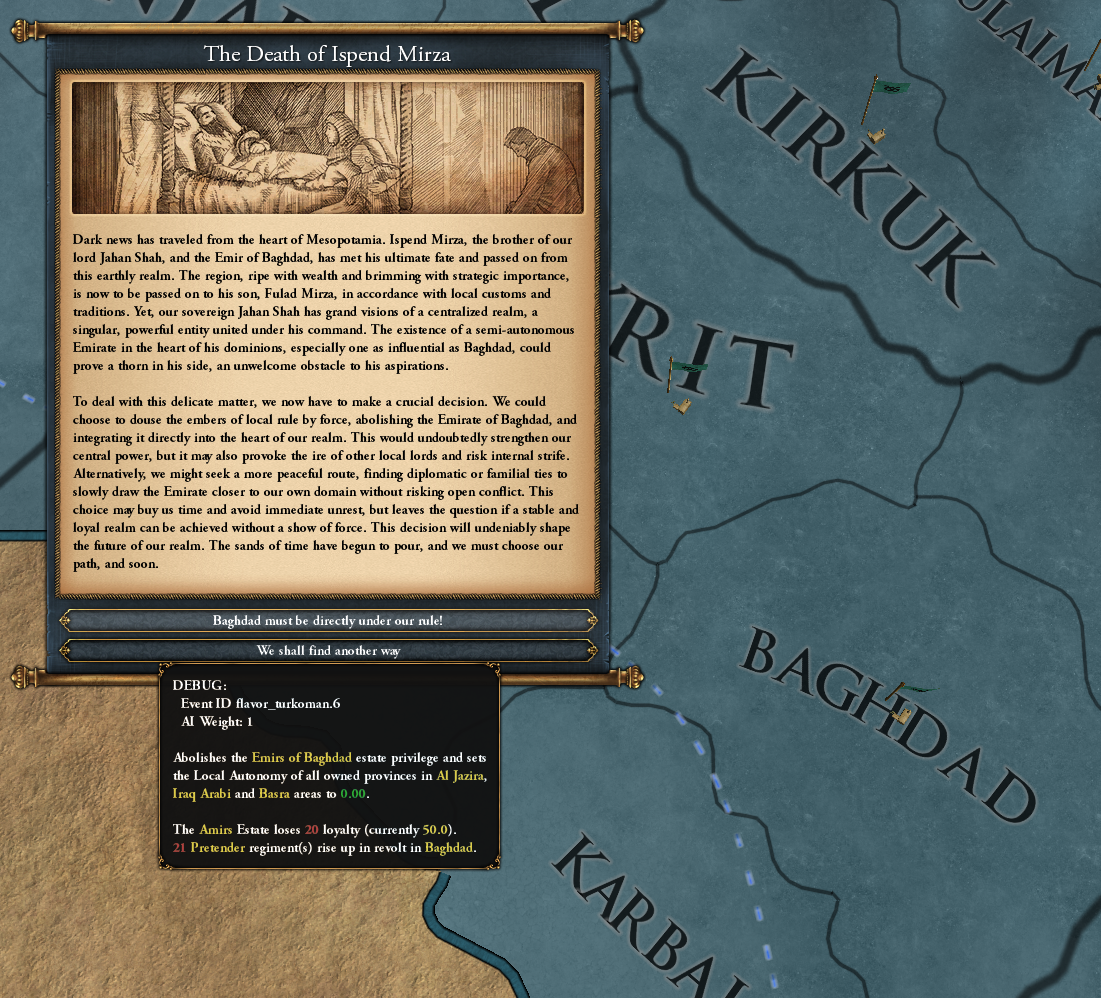
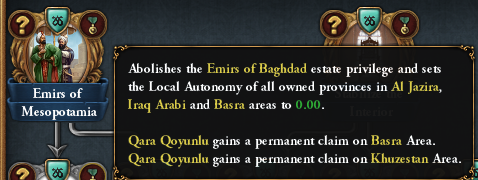
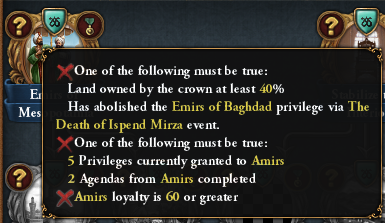
Getting rid of this privilege will be a race against time, as the autonomy of the provinces affected will be very difficult to lower - and at times it may even grow naturally over time.
Against the threat of the Ottomans to the West, not losing a single battle against this fearsome enemy will yield a powerful permanent reward:
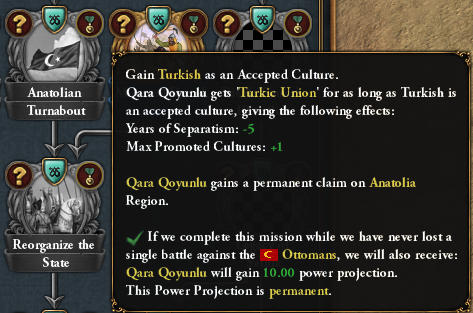
The defeat of the Ottomans will herald a new era of warfare by introducing Janissaries in Tabriz as well as a new Tier 1 Government:

Unlike its Western counterpart, Qara Qoyunlu will facilitate a lot of its expansion into the lands of Persia in a different style, starting with the ‘Princes of Persia’ mission:
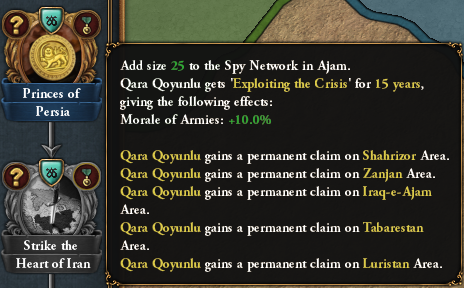
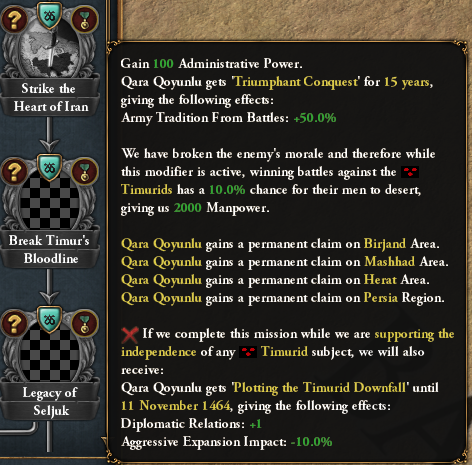
The content for the Turkomans could not be complete without a reference to a very iconic place of worship. The Blue Mosque in Tabriz, also known as the Masjed-e Kabud, is a historic mosque in Iran that earned its name from the stunning blue tiles that once adorned its walls. The mosque was originally built in the 15th century during the rule of the Qara Qoyunlu dynasty and features impressive, intricate architecture with beautiful calligraphy and geometric patterns:
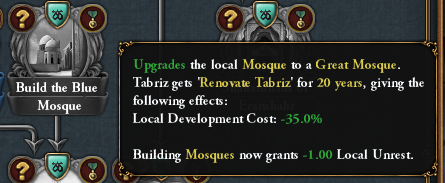
Before we conclude this part of the Developer Diary, here’s some more content for these two countries:
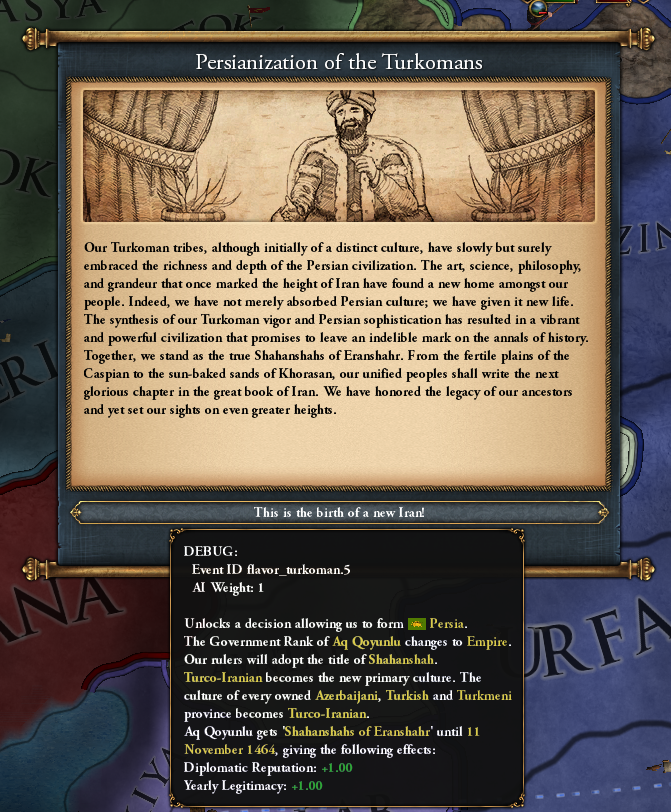
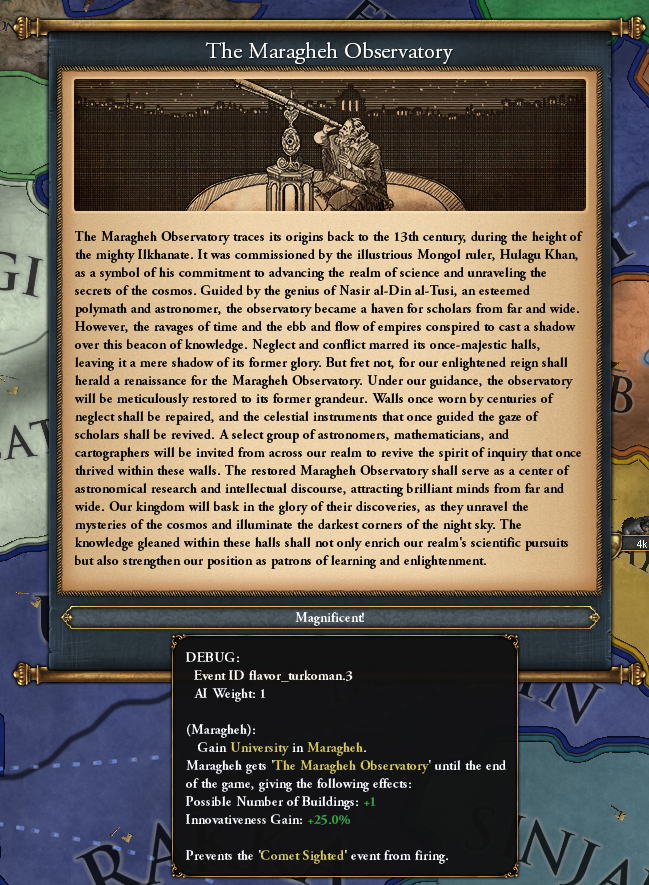
It should be mentioned that the Turkoman trees are designed in a non-restrictive way to allow the player any playstyle - tribal, monarchy, horde. Although the mission tree follows the historical narrative of Persian conquests and Persianization, forming Persia is just an option the player can do at the end of the tree rather than being forced to do it. This philosophy is inspired by forum and Reddit comments by people who are hoping for the ability to stay as AQ/QQ rather than having to form another tag. Lastly, the content shown here is about half of the content planned for the Turkomen, and in the interest of keeping you excited and allowing you the ability to discover the content for yourselves, I decided against fully showcasing more missions, events, etc.
Here we will focus on the new content we have to present on Georgia and Armenia.
Georgia in 1444 was a state in disarray and disintegration. After the Timurid invasions, it broke down into several smaller kingdoms and principalities. The major political entities during this time included the Kingdoms of Kartli, Kakheti, and Imereti, and the Principality of Samtskhe. This fragmentation weakened Georgia's ability to defend itself against external threats and hindered efforts at reunification. To add some more historical accuracy while trying to deal with the looming disaster, we have added a truce between Georgia and Qara Qoyunlu for both gameplay and historical reasons. Jahan Shah of Qara Qoyunlu in fact invaded Georgia in early 1444 and so we depicted it with this short starting truce.
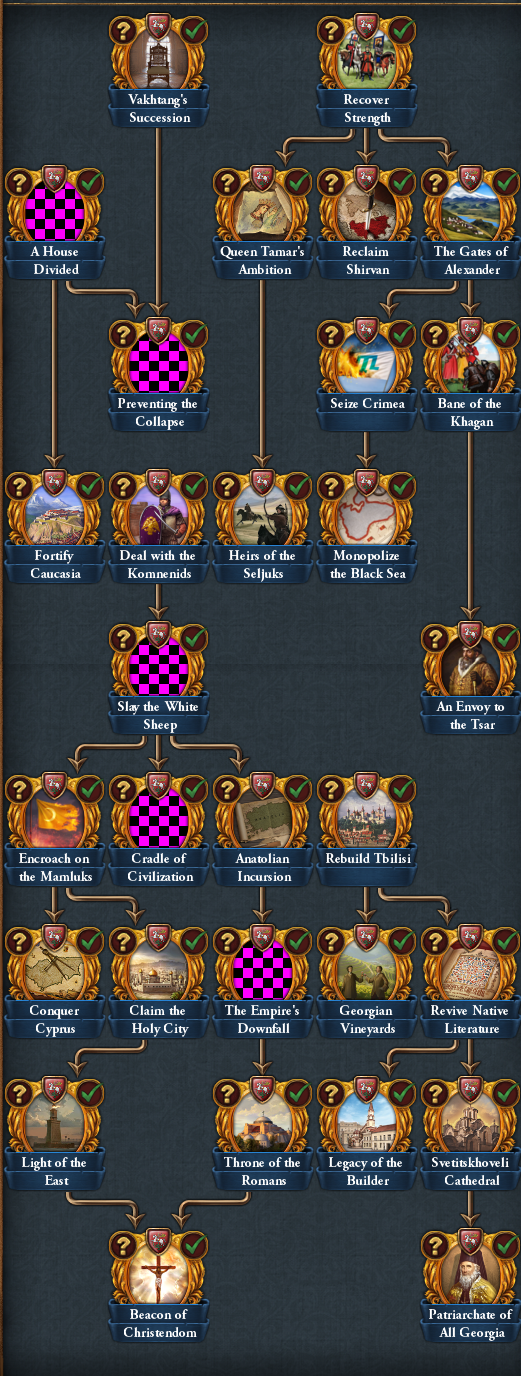
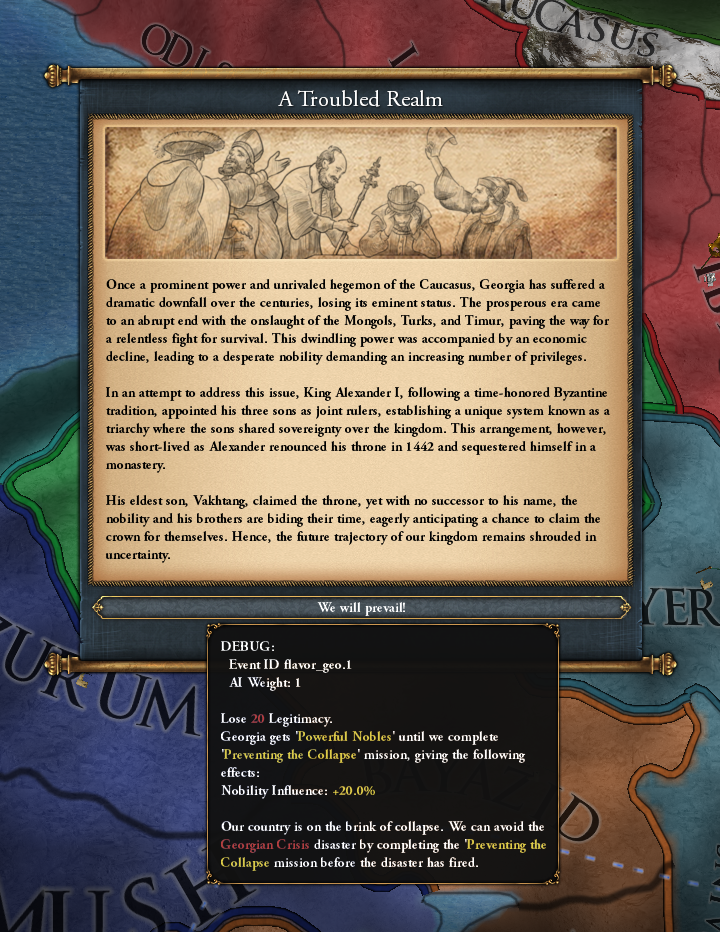
To add more depth to the Georgian content, we have created a new starting disaster to better mirror the situation in the region under the weakened rulership of Vakhtang. 1.36 completely reworks the disintegration of Georgia – in 1444, the country has not yet divided the way it was in 1.35, and so Imereti is now a part of Georgia and Samtskhe starts as its vassal:
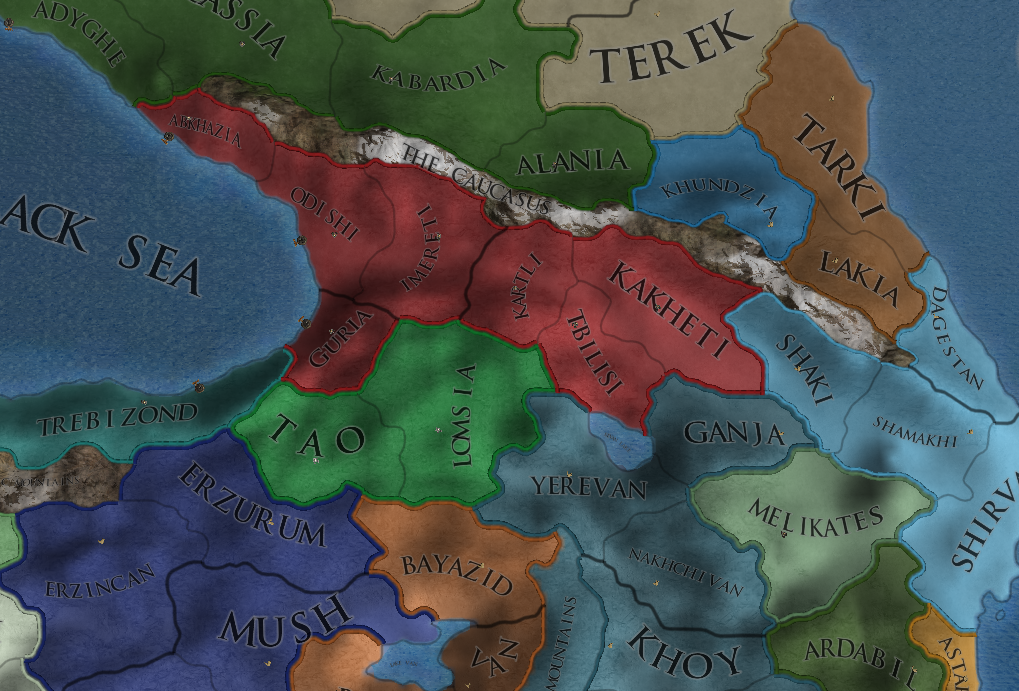
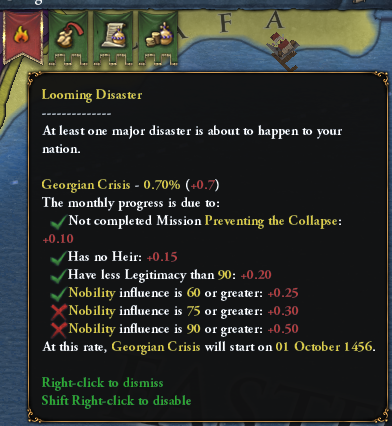
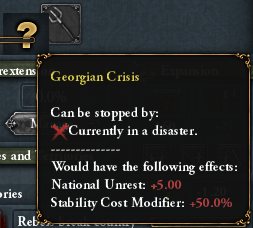
WIP Art.
In order to restore order, you will need to succeed in a multitude of different objectives:
The content of Georgia is designed in a way to facilitate game flow either via overcoming or circumventing the disaster, by completing certain missions within a reasonable time frame:


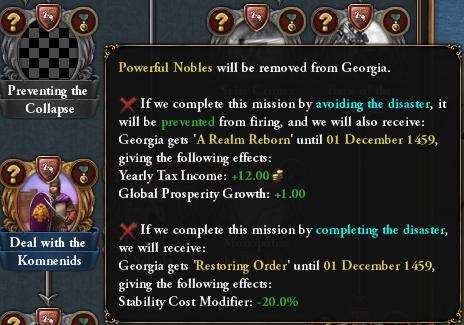
During the disaster, should it fire, there will be several new events occurring to help build and promote the narrative of a torn realm in distress:
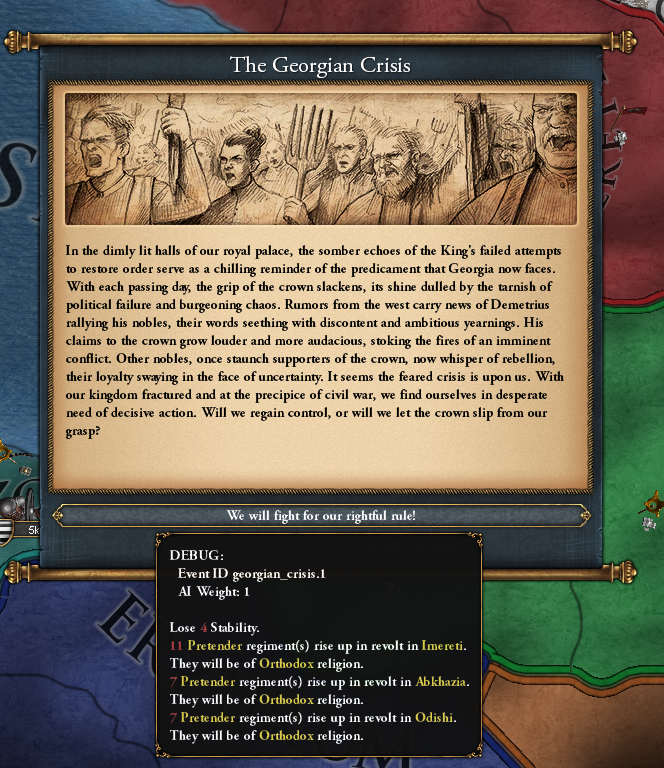
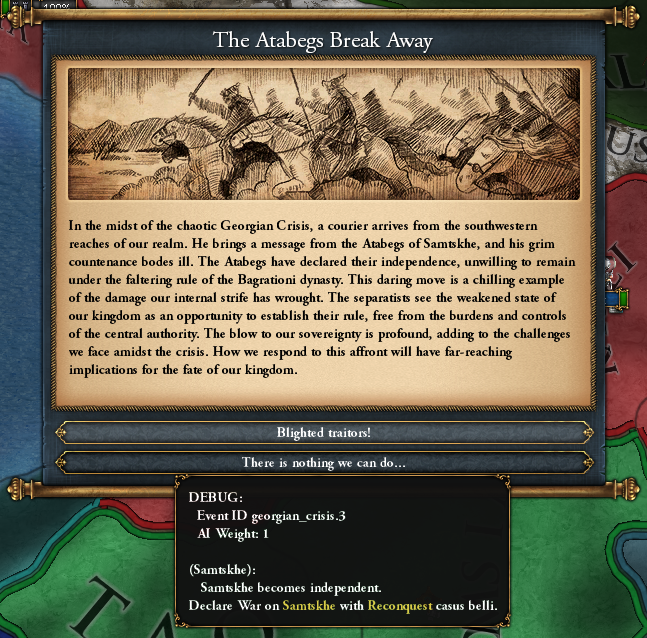
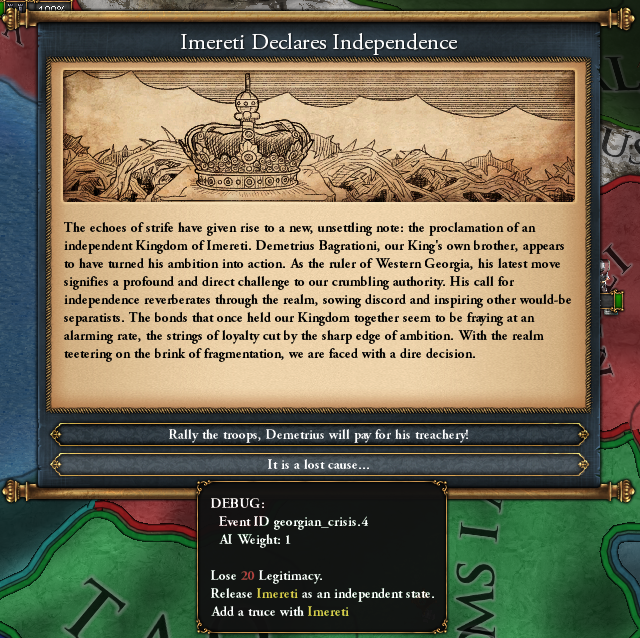
Should you complete these tasks, you will be greeted by this event, announcing the end of a turbulent period:
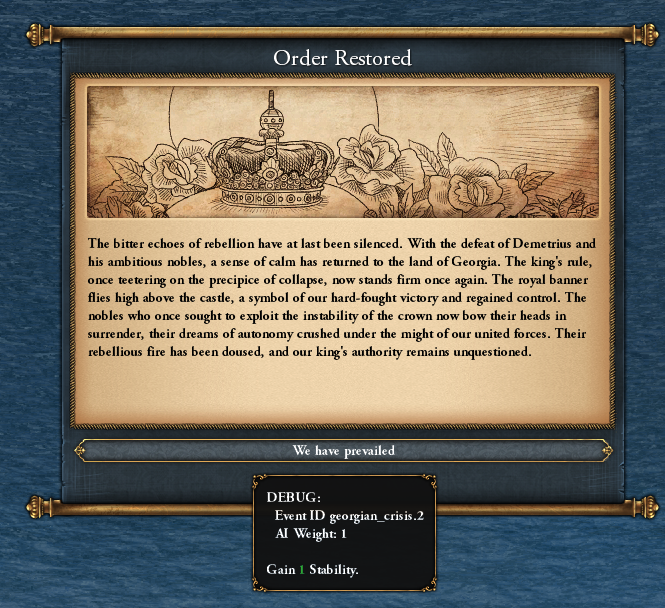
Conquest missions are oriented around the unification of Caucasia, punitive campaigns against the Hordes and, similarly to Armenia, you will be pushing your way across the Middle East and bringing the region back under the rule of the Cross:
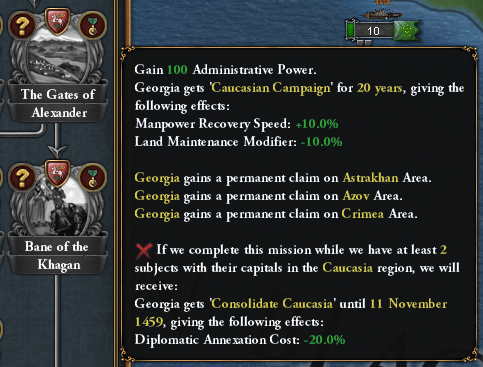
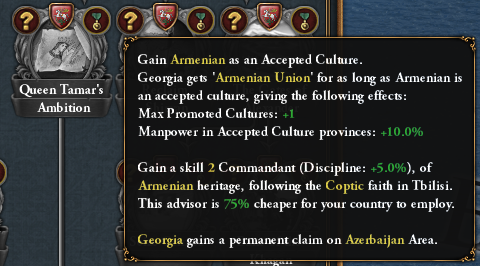
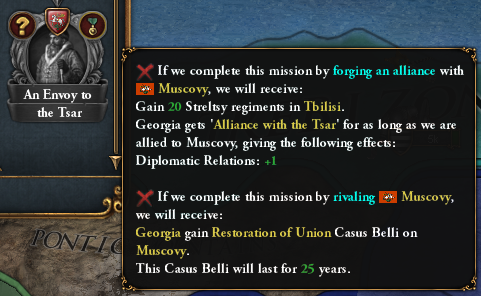

One of the highlights of your conquest missions is the ‘Throne of the Romans’ mission, allowing you to make yourself the rightful heir of the Eastern Roman Empire by moving your capital to Constantinople and your culture to the Byzantine culture group:
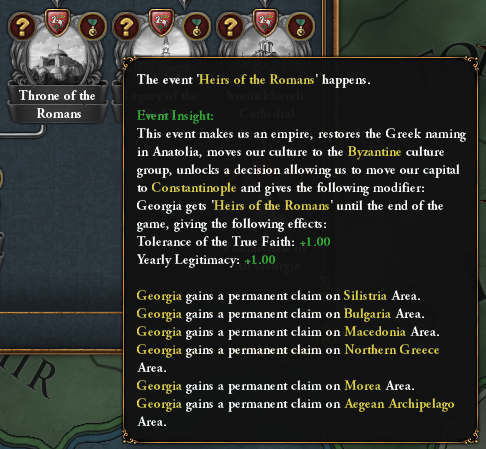
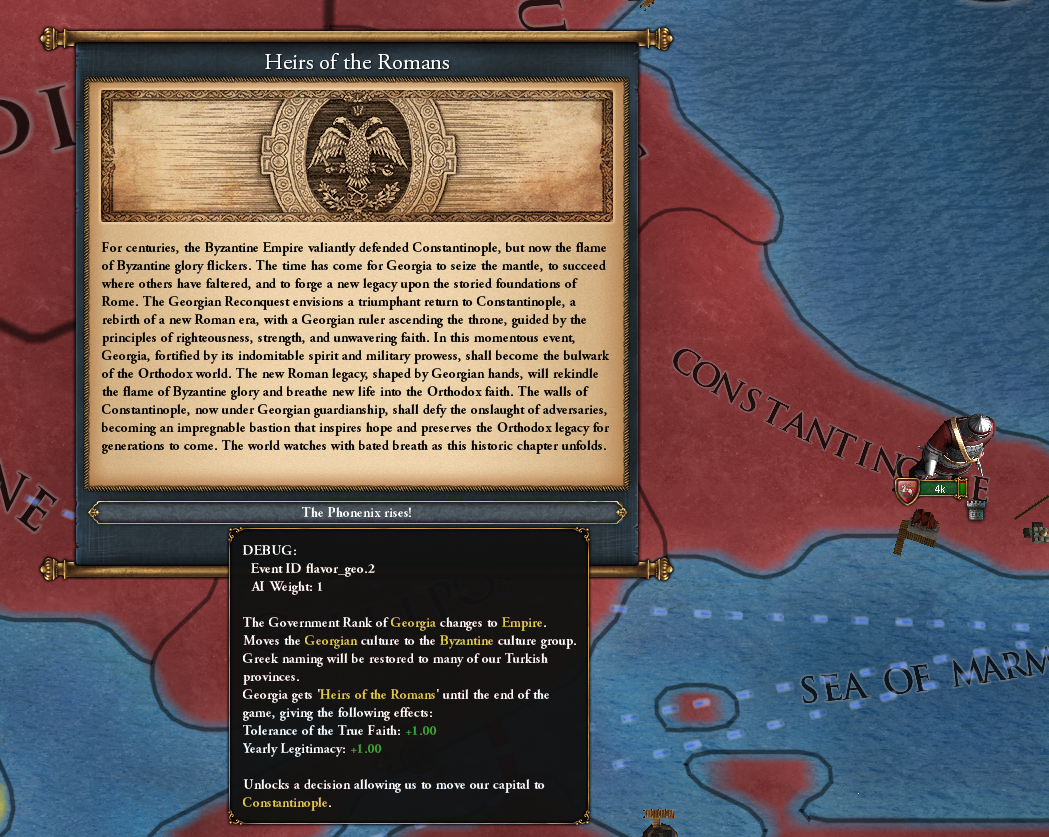
Since Georgia was heavily ravaged by the past wars, your tall missions mostly deal with the restoration of the country and the revival of your culture and religion – you will be restoring the glory of the days of David 'the Builder' and elevating the Autocephalous Church of Georgia into a Patriarchate:
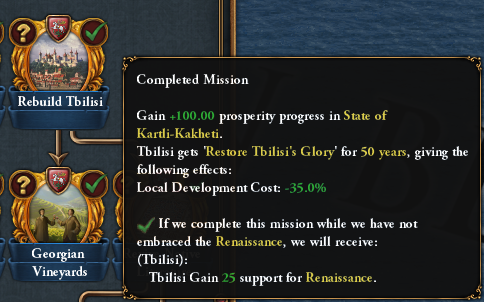
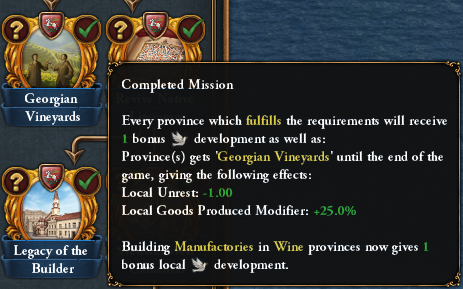
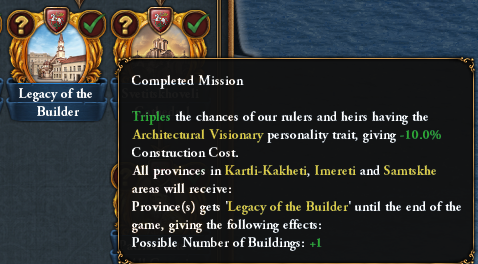

Finally, Georgia also received flavor in other areas of the game, including localized ruler titles, localized government ranks, and historical flavor events about important personalities such as Giorgi Saakadze or Sulkhan-Saba Orbeliani.
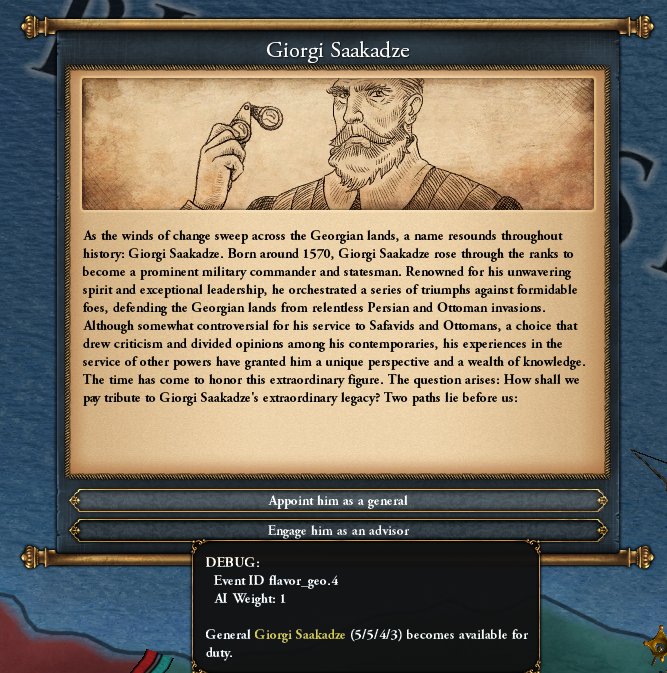
Let’s move forward to Armenia, but first, let us make a comment about it. We have been working on unique content for the Armenian region for a long time, and it reflects our understanding of the historical situation. In no way it is intended to be a comment or reference to the ongoing conflict between Armenia and Azerbaijan or the humanitarian crisis in Nagorno-Karabakh.
Now, let’s go back to the content itself. During the second half of the 15th century, Armenians in the Caucasus faced complex geopolitical shifts. The region was caught in the midst of territorial disputes and power struggles involving the Safavid Persian Empire, the Ottoman Empire, and local rulers. During our timeline in that century, as a Christian minority, Armenian communities often found themselves caught between these larger empires. Some Armenians living in the Caucasus were subjected to religious and political pressures from the Ottoman and Safavid rulers, leading to challenges and occasional persecution.
Karabakh is arguably one of the most difficult tags in the game. The goal of the mission tree is to give them a flavorful and powerful tree without trivializing the difficulty of their early game – the tree does not give you anything before you succeed in securing independence. The narrative of the content is built around the restoration of Mets Hayk – the Greater Armenia, which existed during the glorious reign of the Artaxiad dynasty, but it also takes you beyond that and allows you to exceed the golden age of Armenia by conquering Persia, Anatolia, and Egypt. Lastly, before we delve into the content, forming the Armenian tag is now easier since it no longer requires the province of Adana.
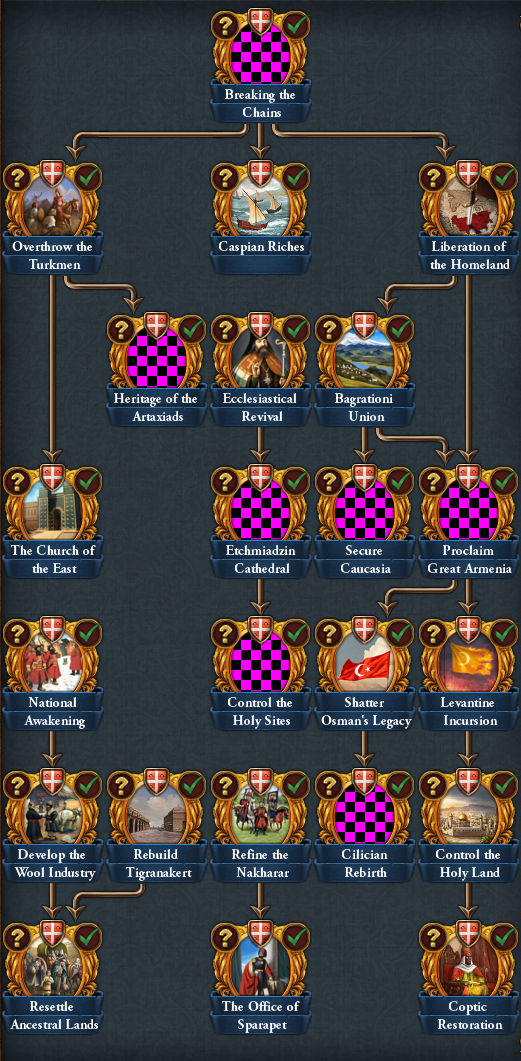
Let’s take a look at some of the conquest-related highlights of the new content for Armenia and Karabakh:
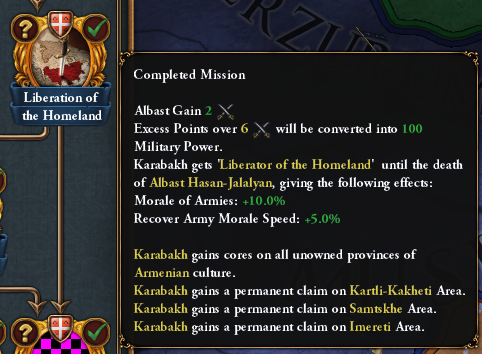
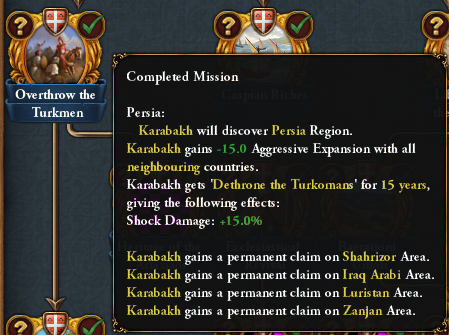
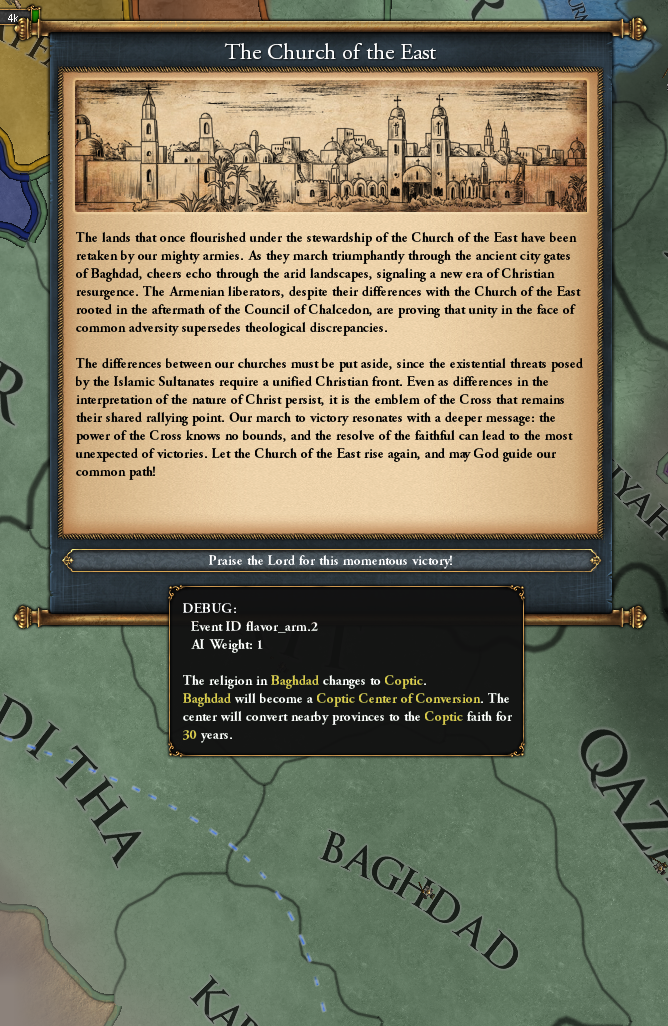
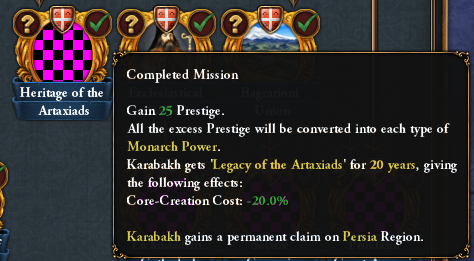
Your conquest missions will have you restore the borders of Great Armenia but also venture into Persia, Mashriq, Anatolia, Egypt, and even Ethiopia. You will be joining with the Churches of the East and gaining powerful rewards, such as a Coptic Center of Conversion in Baghdad, the Defender of the Faith position as a mission reward, an upgrade of the Holy City of Jerusalem Great Project, and access to the Cawa regiments:
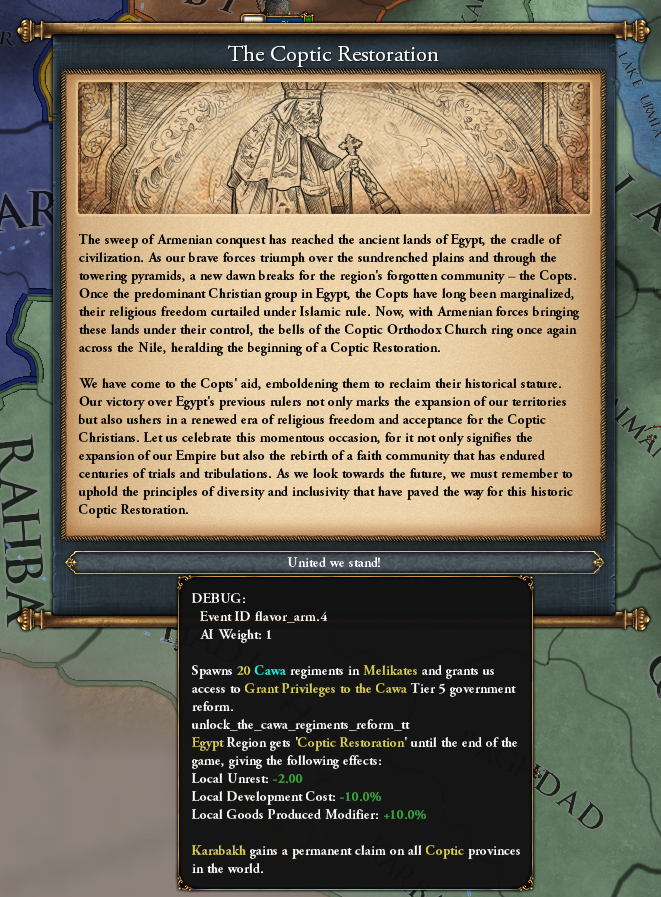
The tooltip is a WIP and it mentions the bonuses of the reform itself, which include the recruitment and improvement of Cawa units from fellow Coptic lands, the reduction of war exhaustion, regiment cost, and more!
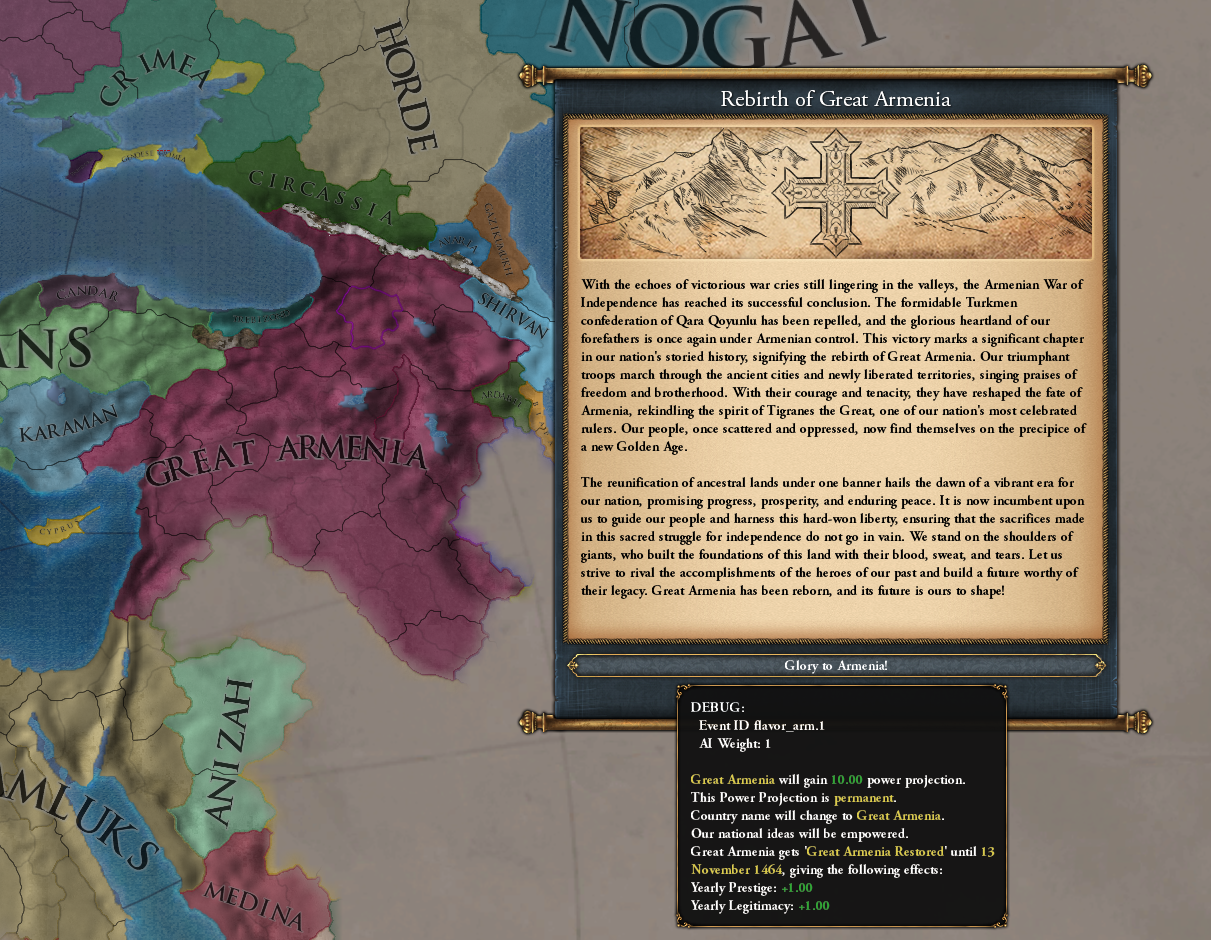
Here are the new Great Armenian ideas:
ARM1_ideas = {
start = {
war_exhaustion = -0.05
recover_army_morale_speed = 0.10
}
bonus = {
hostile_attrition = 1
}
trigger = {
OR = {
tag = ARM
tag = MLK
}
has_country_flag = arm_great_armenian_ideas
}
free = yes #will be added at load.
apostolic_church = {
global_missionary_strength = 0.02
prestige_per_development_from_conversion = 0.25
}
land_reclamation1 = {
development_cost = -0.15
}
border_nation = {
diplomatic_reputation = 1
}
melikdom_organization1 = {
global_tax_modifier = 0.2
}
sygnakhs = {
global_regiment_cost = -0.1
}
nakharar_titles1 = {
army_tradition = 1
}
end_of_armenian_diaspora1 = {
production_efficiency = 0.1
manpower_in_own_culture_provinces = 0.2
}
}
We should note here, before we move to internal-development-related missions, that Armenia also gets access to new government reforms, granted via the missions ‘Refine the Nakharar’ and ‘The Office of Sparapet’.
Your tall missions will have you strengthen the Apostolic Church of Armenia, liberate the holy sites, rebuild the majestic city of Tigranakert, and resettle your ancestral lands with Armenians, unlocking powerful culture conversion rewards such as +1 of all development on culture converting a province to Armenian:
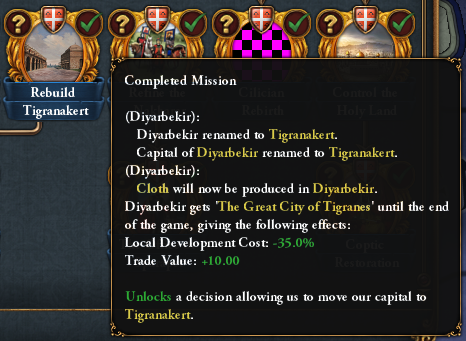
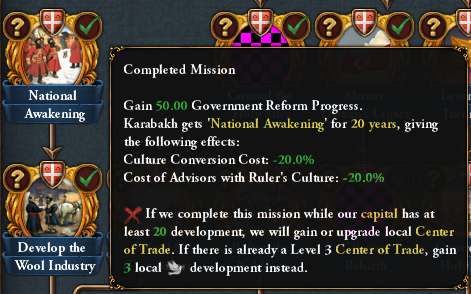
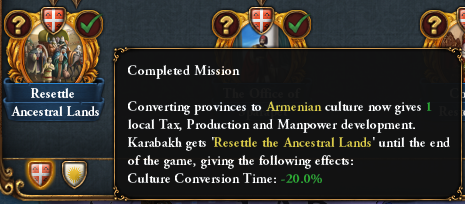
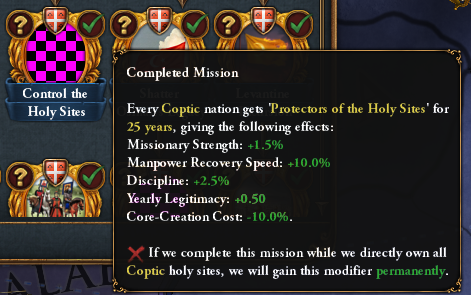
And as has become tradition, this weeks DD comic from FatherLorris:

Thank you for tuning in for another week’s Dev Diaries, next week we will take a look at Yemen and Arabia with Ogele.
Embroiled in both external and internal conflicts, the Turkomans in the Middle East offer a very interesting playthrough including government mechanics, events, and now completely new mission trees, government reforms, and more! Both tags share similar mission trees, each imbued with unique branches for AQ and unique branches for QQ.


QQ and AQ will largely share most missions, each tree granting certain diversity in key points.
Despite its smaller size compared to its Eastern neighbor, AQ starts at a much stable situation (more on that further down!). In 1444 the legendary Uzun Hasan stands as the heir to a Tribal Federation ready to spread its wings and bring the surrounding territory under its heel.
The AQ mission tree offers 31 new missions, interacting with nearly every facet of gameplay, from conquest and integration to estate interaction and events. Your first tasks would be to eradicate the last remnant of the Ayyubids in Hisn Kayfa, and rally your powerful cavalry. The former will then give rise to aspirations for expansion in every direction while the latter mission (Rally the Turkomans) will play around with the existing Tribal Allegiance mechanic and grant a bonus to province warscore cost.

At the same time, you will be called to eradicate one of the last Roman bastions in Eastern Anatolia, Trebizond, offering a unique event reward:


The first option of the event will grant some prosperity over time in the entire state as well as some reduction to local autonomy among other minor rewards.
Another highlight of the Aq Qoyunlu conquest path is “The House of Wisdom”. The House of Wisdom in Baghdad was a renowned center of scholarship and intellectual activity in the Islamic world. Established during the Abbasid Caliphate in the 8th and 9th centuries, it continued to flourish into later centuries, being a hub of learning, translating, and preserving ancient Greek, Persian, and Indian texts, contributing significantly to the Islamic Golden Age. Scholars from various backgrounds gathered there to engage in scholarly pursuits, making significant advances in fields like astronomy, mathematics, medicine, and philosophy. The House of Wisdom's enduring legacy lies in its role in preserving and transmitting knowledge, which later influenced the European Renaissance and the broader development of human civilization. Therefore, there will be a mission about fully restoring it:

To wrap up the showcasing of conquest for Aq Qoyunlu, let’s take a look at “A Gunpowder Empire”. This is a term coined for empires such as the Ottomans, Safavids, and Mughals, as they used this new warfare technology to expand their territories and dominate their regions. Their military strength and control over trade routes were largely built upon their mastery of gunpowder weaponry and tactics, and Aq Qoyunlu may be able to join that group as well:

Moving on to the internal part of the content, we will be greeted by objectives centered around an improved court, the patronization of art and literature, as well as the development of new imperial fabrics:




Finally, let’s take a look at some more highlights before we move on to the Black Sheep:


The Black Sheep on the Eastern border suffered a turbulent time during the middle of the 15th century. In 1444 the lands around Mesopotamia were highly autonomous and far away from the central domain in Tabriz. As a result, the lands that fell in the hands of Ispend Mirza (brother of Jahan Shah) created a thorn in the side of the government, resisting the payment of taxes and drafts, thus posing a significant threat to Jahan’s rule. We decided to represent the Emirate of Baghdad via an Estate Privilege, which increases the autonomy in select areas via a flat and a monthly amount:



Getting rid of this privilege will be a race against time, as the autonomy of the provinces affected will be very difficult to lower - and at times it may even grow naturally over time.
Against the threat of the Ottomans to the West, not losing a single battle against this fearsome enemy will yield a powerful permanent reward:

The defeat of the Ottomans will herald a new era of warfare by introducing Janissaries in Tabriz as well as a new Tier 1 Government:

Unlike its Western counterpart, Qara Qoyunlu will facilitate a lot of its expansion into the lands of Persia in a different style, starting with the ‘Princes of Persia’ mission:


The content for the Turkomans could not be complete without a reference to a very iconic place of worship. The Blue Mosque in Tabriz, also known as the Masjed-e Kabud, is a historic mosque in Iran that earned its name from the stunning blue tiles that once adorned its walls. The mosque was originally built in the 15th century during the rule of the Qara Qoyunlu dynasty and features impressive, intricate architecture with beautiful calligraphy and geometric patterns:

Before we conclude this part of the Developer Diary, here’s some more content for these two countries:


It should be mentioned that the Turkoman trees are designed in a non-restrictive way to allow the player any playstyle - tribal, monarchy, horde. Although the mission tree follows the historical narrative of Persian conquests and Persianization, forming Persia is just an option the player can do at the end of the tree rather than being forced to do it. This philosophy is inspired by forum and Reddit comments by people who are hoping for the ability to stay as AQ/QQ rather than having to form another tag. Lastly, the content shown here is about half of the content planned for the Turkomen, and in the interest of keeping you excited and allowing you the ability to discover the content for yourselves, I decided against fully showcasing more missions, events, etc.
Here we will focus on the new content we have to present on Georgia and Armenia.
Georgia in 1444 was a state in disarray and disintegration. After the Timurid invasions, it broke down into several smaller kingdoms and principalities. The major political entities during this time included the Kingdoms of Kartli, Kakheti, and Imereti, and the Principality of Samtskhe. This fragmentation weakened Georgia's ability to defend itself against external threats and hindered efforts at reunification. To add some more historical accuracy while trying to deal with the looming disaster, we have added a truce between Georgia and Qara Qoyunlu for both gameplay and historical reasons. Jahan Shah of Qara Qoyunlu in fact invaded Georgia in early 1444 and so we depicted it with this short starting truce.


To add more depth to the Georgian content, we have created a new starting disaster to better mirror the situation in the region under the weakened rulership of Vakhtang. 1.36 completely reworks the disintegration of Georgia – in 1444, the country has not yet divided the way it was in 1.35, and so Imereti is now a part of Georgia and Samtskhe starts as its vassal:



WIP Art.
In order to restore order, you will need to succeed in a multitude of different objectives:
- Increase legitimacy to 90
- Produce an heir
- Increase your stability to at least 1
- No provinces controlled by rebels
The content of Georgia is designed in a way to facilitate game flow either via overcoming or circumventing the disaster, by completing certain missions within a reasonable time frame:



During the disaster, should it fire, there will be several new events occurring to help build and promote the narrative of a torn realm in distress:



Should you complete these tasks, you will be greeted by this event, announcing the end of a turbulent period:

Conquest missions are oriented around the unification of Caucasia, punitive campaigns against the Hordes and, similarly to Armenia, you will be pushing your way across the Middle East and bringing the region back under the rule of the Cross:




One of the highlights of your conquest missions is the ‘Throne of the Romans’ mission, allowing you to make yourself the rightful heir of the Eastern Roman Empire by moving your capital to Constantinople and your culture to the Byzantine culture group:


Since Georgia was heavily ravaged by the past wars, your tall missions mostly deal with the restoration of the country and the revival of your culture and religion – you will be restoring the glory of the days of David 'the Builder' and elevating the Autocephalous Church of Georgia into a Patriarchate:




Finally, Georgia also received flavor in other areas of the game, including localized ruler titles, localized government ranks, and historical flavor events about important personalities such as Giorgi Saakadze or Sulkhan-Saba Orbeliani.

Let’s move forward to Armenia, but first, let us make a comment about it. We have been working on unique content for the Armenian region for a long time, and it reflects our understanding of the historical situation. In no way it is intended to be a comment or reference to the ongoing conflict between Armenia and Azerbaijan or the humanitarian crisis in Nagorno-Karabakh.
Now, let’s go back to the content itself. During the second half of the 15th century, Armenians in the Caucasus faced complex geopolitical shifts. The region was caught in the midst of territorial disputes and power struggles involving the Safavid Persian Empire, the Ottoman Empire, and local rulers. During our timeline in that century, as a Christian minority, Armenian communities often found themselves caught between these larger empires. Some Armenians living in the Caucasus were subjected to religious and political pressures from the Ottoman and Safavid rulers, leading to challenges and occasional persecution.
Karabakh is arguably one of the most difficult tags in the game. The goal of the mission tree is to give them a flavorful and powerful tree without trivializing the difficulty of their early game – the tree does not give you anything before you succeed in securing independence. The narrative of the content is built around the restoration of Mets Hayk – the Greater Armenia, which existed during the glorious reign of the Artaxiad dynasty, but it also takes you beyond that and allows you to exceed the golden age of Armenia by conquering Persia, Anatolia, and Egypt. Lastly, before we delve into the content, forming the Armenian tag is now easier since it no longer requires the province of Adana.

Let’s take a look at some of the conquest-related highlights of the new content for Armenia and Karabakh:




Your conquest missions will have you restore the borders of Great Armenia but also venture into Persia, Mashriq, Anatolia, Egypt, and even Ethiopia. You will be joining with the Churches of the East and gaining powerful rewards, such as a Coptic Center of Conversion in Baghdad, the Defender of the Faith position as a mission reward, an upgrade of the Holy City of Jerusalem Great Project, and access to the Cawa regiments:

The tooltip is a WIP and it mentions the bonuses of the reform itself, which include the recruitment and improvement of Cawa units from fellow Coptic lands, the reduction of war exhaustion, regiment cost, and more!

Here are the new Great Armenian ideas:
ARM1_ideas = {
start = {
war_exhaustion = -0.05
recover_army_morale_speed = 0.10
}
bonus = {
hostile_attrition = 1
}
trigger = {
OR = {
tag = ARM
tag = MLK
}
has_country_flag = arm_great_armenian_ideas
}
free = yes #will be added at load.
apostolic_church = {
global_missionary_strength = 0.02
prestige_per_development_from_conversion = 0.25
}
land_reclamation1 = {
development_cost = -0.15
}
border_nation = {
diplomatic_reputation = 1
}
melikdom_organization1 = {
global_tax_modifier = 0.2
}
sygnakhs = {
global_regiment_cost = -0.1
}
nakharar_titles1 = {
army_tradition = 1
}
end_of_armenian_diaspora1 = {
production_efficiency = 0.1
manpower_in_own_culture_provinces = 0.2
}
}
We should note here, before we move to internal-development-related missions, that Armenia also gets access to new government reforms, granted via the missions ‘Refine the Nakharar’ and ‘The Office of Sparapet’.
Your tall missions will have you strengthen the Apostolic Church of Armenia, liberate the holy sites, rebuild the majestic city of Tigranakert, and resettle your ancestral lands with Armenians, unlocking powerful culture conversion rewards such as +1 of all development on culture converting a province to Armenian:




And as has become tradition, this weeks DD comic from FatherLorris:

Thank you for tuning in for another week’s Dev Diaries, next week we will take a look at Yemen and Arabia with Ogele.